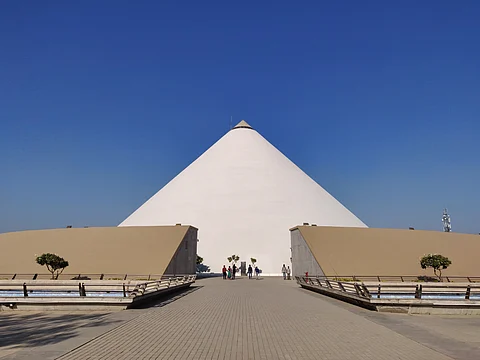
- Destinations
- Experiences
- Stay
- What's new
- Editor’s Picks
- Responsible Tourism
- CampaignsCampaigns
- Subscribe

Bapu, Gandhiji, The Mahatma, the father of our nation, there are many names for Mohandas Karamchand Gandhi, the exponent of non-violence, tolerance, peace, and the greatest and most effective weapon against colonial rule in India. Here are five fascinating museums which enshrine his life and philosophy.
Dandi Kutir, Gandhinagar, Gujarat
It is reported to be the country's largest and only museum built on the life and teachings of Mahatma Gandhi. It is representative of the Mahatma's ideas on people across lines of class, gender, age, and community asserting their common right to salt during British rule. The Dandi salt satyagraha march was a civil disobedience movement against colonial rule and a symbol to inspire a pluralistic society to march towards independence or purna swaraj.
Kirti Mandir, Porbandar, Gujarat
The Gandhi family's ancestral home, where Mahatma Gandhi was born on 2nd October 1869, abuts Kirti Mandir. The national museum is a memorial for Gandhiji and his wife, Kasturba, and features a photo exhibit depicting Gandhi's life journey. Industrialist Nanjibhai Kalidas Mehta commissioned it. Kirti Mandir was built in 1947 by Darbar Gopaldas Desai, a prominent Gandhian and communist. The house where Gandhiji was born was once a three-storeyed structure built by Mahatma Gandhi's grandfather.
For more information on how to reach, tickets, and timings, check the website.
Gandhi Mandap Maidan, Guwahati, Assam
Located on the hilltop of Sarania Hill, the Gandhi Mandap Maidan Museum is one of Guwahati's vantage points, with vehicle access only. Gandhiji visited Assam four times between 1921 and 1946, and frenzied crowds greeted him. During his first visit, the people of Assam were ready and enthused about the non-cooperation movement. The last visit in 1946 of the Mahatma was to advise the Assamese people to be steadfast about themselves as a community and avoid communal uprisings. At the Gandhi Mandap Maidan, the Assam government has installed a 300-foot-high flagpole with a 120&prime x 80&prime flag.
For more information on how to reach, tickets, and timings, check the website.
Mani Bhavan Gandhi Sangrahalaya, Mumbai, Maharashtra
A modest two-storeyed structure on Laburnum Road in Gamdevi played a pivotal part in India's freedom struggle. Originally the building belonged to ardent Gandhian Revashankar Jagjeevan Jhaveri, which was the nerve centre in Mumbai for Gandhiji's activities from 1917-1934. It was from Mani Bhavan that the first phase of the non-violent freedom struggle was launched. The satyagraha against the Rowlatt Act started from Mani Bhavan in March 1919 to defy the Indian Press Act, it was from here that Gandhiji began his weekly bulletin "Satyagrahi" on 7th April 1919 at the time of the boycott of the visit of the Prince of Wales on 17th November 1921, Gandhiji started his historic fast at Mani Bhavan on 19th November 1921. It was at Mani Bhavan that the decision was taken to launch the civil disobedience on 31st December 1931.
For more information on how to reach, tickets, and timings, check the website.
Gandhi National Memorial Society, Pune, Maharashtra
It was at the Aga Khan Palace in Pune where Gandhiji, his wife Kasturba Gandhi, Mahadev Bhai Desai, Sarojini Naidu and other national leaders were incarcerated following the launch of the Quit India Movement in 1942. They were here from 5th August 1942 to 6th May 1944. During this time, Mahadev Bhai and Kasturba Gandhi passed away. Their samadhis (memorials) are located here. After the demise of his wife, Gandhiji expressed that the palace should be developed into a place of Emancipation of Women. Then in 1969, on the occasion of Gandhiji's birth centenary, HH Prince Karim Aga Khan donated the palace to the nation.
For more information on how to reach, tickets, and timings, check the website.
ALSO READ Experiencing Gujarat In Gandhi's Footsteps.
